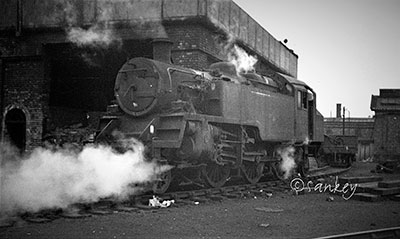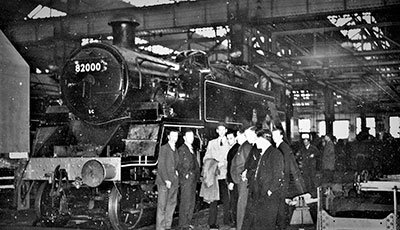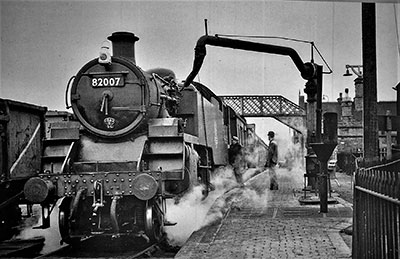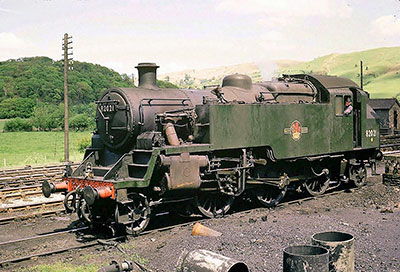
News Update - December 2020
Engineering notes
By Tony Massau
2020 has not been the best of years for progress on 82045. Two lockdowns when work ceased and some restrictions in place when we are on site in an effort to keep everyone safe. Our own team of machinists work on Sundays when the full time engineering staff are absent and access to the machine shop is more readily available. The rest of us continue on our normal Mondays and Wednesdays but we are not allowed to form a crowd inside the workshops, only any three of us at any one time respecting social distancing is permitted. The outdoor work on the pony trucks has occupied us most of the time and as was reported previously the front pony truck was put on to its wheel set just before the second lockdown. A minor adjustment to the axleboxes was then discovered which will necessitate lifting off the wheel set again for a short time. This will be tackled as soon as possible in the new year. The axleboxes for the rear pony truck, which had not yet been fitted, have been adjusted accordingly already so they should hopefully go on and stay on.
Various lubrication pipe runs continue to be made and the steam supply to the brake cylinder is being considered whilst access to the cylinder under the cab is easier before the rear pony truck is fitted in position.
Cylinder end cover cladding and steam chest end cover cladding has been made. Quite a time consuming task particularly around the steam chests where various different pieces make up the whole.
Work is also in hand on brackets for the sanding equipment, parts for the rocking grate mechanism and support brackets for the master mechanics spark arresting screens in the smokebox. The latter may not be needed for heritage line use at the present time but it was thought preferable to fit the brackets into a new and clean smokebox than possibly having to do it at some time in the future when the smokebox will be dirty and very unpleasant to work in.
Firebox work continues with much marking out and some preparatory hole drilling underway on various individual sections so it will be a little while yet before the recognisable shape of a Belpaire firebox appears.
82045 in 2020
By Chris Proudfoot
I've just read through the notes I wrote this time last year. Time is a curious thing, isn't it? - truth to tell, none of us has any idea what it really is, when you come to think about it - because on the one hand it seems like only yesterday that I was writing them. On the other, though, it feels like an age ago: we'd just heard that a mysterious new virus had appeared in China, but that was a long way away and therefore little cause for us to be concerned. Little did we know.
Anyway, enough of that. I think we are all suffering from huge information overload, so I will cut straight to the chase, trying to avoid any references to political correctness, and sum up the state of play with regard to 82045. Most of what I said last year is still relevant, but it can't be denied that the events of 2020 have affected progress on the new locomotive and will mean that the completion date will be somewhat later than we'd been hoping. Last year, I suggested that we might be looking at late 2021 or early 2022, and I think you have to add at least six months to this rough estimate, bearing in mind the repeated lockdowns, plus the social distancing that means our chaps can't get their heads together, which is what they literally have to do for some jobs. It remains uncertain how long the situation is likely to continue, so we can only hope for the best. Tony has given you the engineering perspective on this in his notes, so I will simply say that, despite all the difficulties, the overall situation remains very positive: work has proceeded on all fronts to the absolute extent that this has been feasible, the project is secure, and we are already working hard to ensure that 82045 remains viable as a working locomotive for as long as possible.
The Future Fund, re-invigorated last year after a somewhat premature launch in 2017, has proved a great success, since many of our friends and supporters share our determination that the engine should not end up stuffed and mounted in the Engine House, nice as the Engine House is. While we can still draw breath, this will be a priority. There will come a time when we will have to hand over to younger folks - our friends at the Stanier Mogul Fund, far-sighted as always, have already grasped the importance of this - to take over the baton from us, and this will need to be addressed, sooner rather than later.
My colleague Ivan Whitehouse - he took some of the 'official' photographs when we ran the two Eardington specials with 1450 and 'Waterloo Sunset' with Taw Valley- has been busy rooting out photographs of the 82XXX in BR days, and I am following up these notes with a selection of ten very varied shots, taken in locations as geographically diverse as Machynlleth, Woking, Scarborough - and a mystery one. I've made a rough guess as to where this was taken, but I throw it open to you to let me know if you can identify the place. Looking through the images that Ivan has sent reminded me of how widely distributed these little tanks were during their all-too-brief lives.
Well, I think that's about it for 2020. The Winter Solstice is imminent, so we can look forward at least to its not getting any darker. Let's hope also that we can look forward to a better year next year. As ever, many thanks to you all for continuing to support 82045 so generously: we will continue to do our utmost to be worthy of your trust.
annum hoc meliorem exoptemus! (let's hope for a better year than this one).
Stay safe and stay sane.
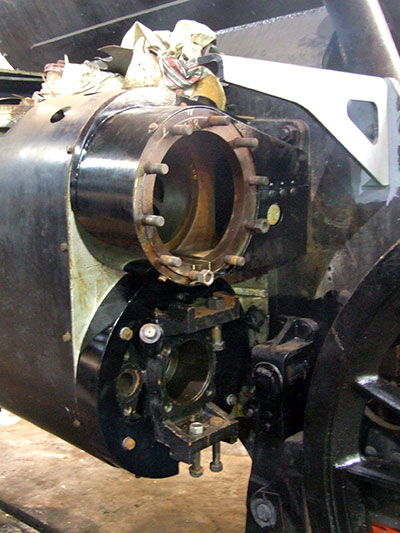
Cladding around rear of steam chest and cylinder. Photo: Jim Norman.
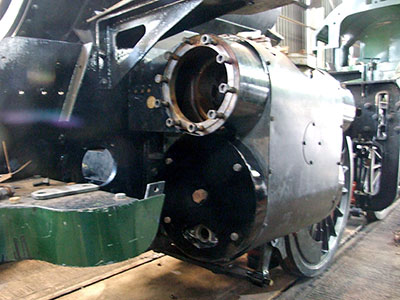
Cladding around front of steam chest and cylinder. Photo: Jim Norman.
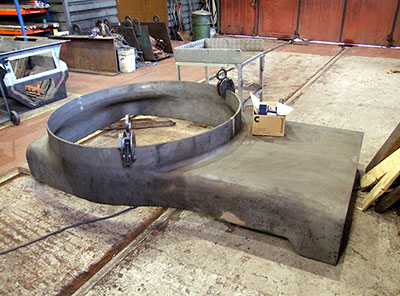
The firebox throatplate. Photo: Jim Norman.

The two radius rods manufactured by Stephenson Engineering. Photo: Tony Massau.
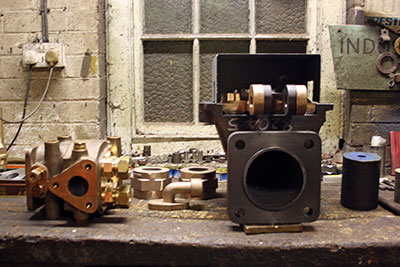
The vacuum ejector and regulator valve assembly close to completion. Photo: Tony Massau.
The 82XXX Tanks in BR Days
Where possible, these images have been credited to the photographer, or to the parties now responsible for their safekeeping. We apologise for the fact that some photographs are uncredited. If anyone knows their provenance, please get in touch with Chris so that the appropriate acknowledgement can be made.
82000 is seen here in a woebegone state at Patricroft mpd on 19th November 1966. Four of the tanks were transferred to this Salford shed in 1965 but had little work to do and the shadows are plainly closing in on the class doyen. It was withdrawn the following month. Photo: Paul Sankey. (Click on the image for a larger version)
The same engine, but at the other end of its life. A pristine 82000 at Swindon in early 1952, surrounded by members of the Mutual Improvement Class from Tyseley depot on a Works visit. Photo: Mr McCarthy. (Click on the image for a larger version)
82007 takes water at the end of Platform 1 at a very recognisable Bridgnorth. The engine was allocated to 84G (Shrewsbury) from 1955 to 1958. Note the unlined green livery and large BR 'cycling lion' totem on the tankside. This is a scene that we hope will be repeated many times in the future, though these days engines working in the Up direction generally have their tanks filled before they leave Bridgnorth shed yard. (Click on the image for a larger version)
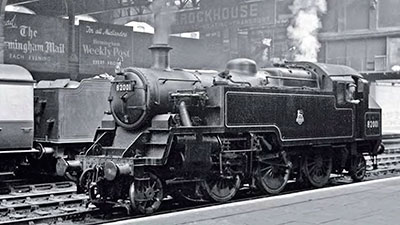
82001 at Snow Hill in 1953. Lined black livery, small BR totem, lots of nostalgic period detail for our Brummie friends!
82021 on an unspecified date. The rural background suggests that the location is Machynlleth, where the engine was based from 1960 to 1964. Prior to this, 82021 had been allocated to Rhosddu shed (Wrexham), and was the first 82XXX I spotted, back in 1959 near Penyffordd in Flintshire at the head of a Wrexham to Bidston train. I remember being astonished at the sight of a smartly painted green tank engine, having been accustomed to uniform dirty grey on my local CLC. (Click on the image for a larger version)
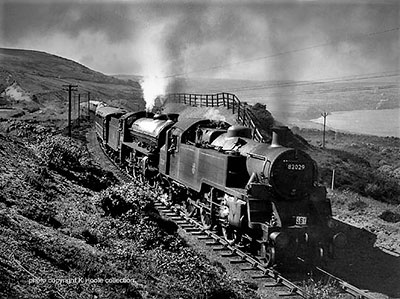
82029 piloting an unidentified B1 (or is it a K1?) on a Scarborough excursion with the North Sea in the background. The 3MT spent most of its life in the North East before gravitating to the SR in 1963. Photo: David Hay collection
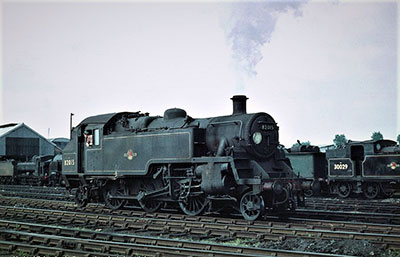
82015 fronts an interesting variety of SR locomotives at Eastleigh shed. The engine was allocated to Eastleigh from new in 1952 and stayed there for ten years. The presence of what appears to be a Urie H15 in the left background suggests that this shot dates from the 1950's.
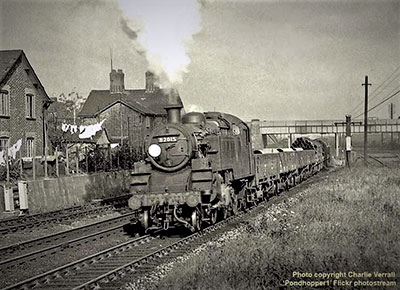
The same engine heads a mixed goods near Fawley. Eastleigh-allocated 82XXX were often used on the heavy Fawley oil tank trains, double-headed and sometimes coupled nose-to-nose.

An atmospheric shot of 82006 at Woking. This engine was only briefly in the South of England, having been transferred from Machynlleth to the SR in May 1965. It was withdrawn from Nine Elms just over a year later.
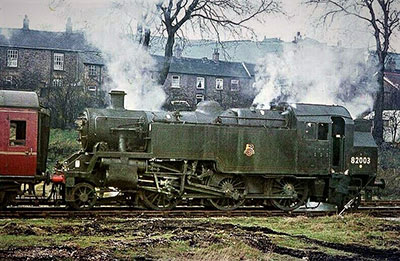
Here's the mystery shot. In nice condition, 82003 heads a train at an unknown location. Although the engine is in full WR regalia, complete with yellow RA disc and fireman's grab handle just in front of the dome, I'm not certain that this was taken in Wales, at least not in the North of the country. The background looks more like the North of England to me - 82003 spent the last couple of years of its life at Patricroft - but I'd be happy to be corrected. It spent time at Treherbert and Carmarthen sheds earlier in its career, so anyone familiar with South Wales might be able to enlighten me. Certainly, the engine's smart appearance and early BR totem suggest that it wasn't near the end of its life.
